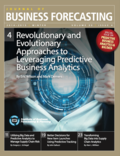 Cart
(0)
Sign In
Cart
(0)
Sign In
- Type of content
- All Knowledge
- Analytics
- Process
- Technology
- People
11
Articles Available
In my last column, I discussed the importance of sales forecasting at industrial product companies. Since sales organizations are the most important organization in creating and shaping customer demand, I advised managers in these companies to get more involved with sales managers during the demand forecasting and planning process. I briefly mentioned that integrating information from CRM systems would provide useful insight for improving accuracy as well as sales productivity. In this column I discuss how three components of CRM systems might improve these processes for both industrial and consumer product companies.
Summer 2018
It is a mystery to me why anyone would manually cleanse the actual demand history given all the advancements in data collection, storage, processing, and predicative analytics. In my experience, whenever a company separated historical baseline volume from the promoted volume, and then added them back together using judgment (also known as layering), 1 + 1 tended to equal 5, instead of 2.
Fall 2016
5
Big data and predictive analytics have brought demand forecasting more into the world of science than art. Unfortunately, many businesses still rely solely on intuition and the analysis of internal historical financial data in their decision-making. That’s risking a lot, given that external influences drive as much as 85 percent of a company’s performance.
Spring 2016
5
Most demand forecasting and planning initiatives are abandoned or considered failures due in part to data quality challenges. The right data input to the demand forecasting and planning process has several important dimensions that need to be considered for success of any process. Harnessing the right data for demand forecasting and planning always appears to be straightforward and relatively simple. However, bad data, or use of the wrong data, often is the real reason behind a demand forecasting and planning process failure.
Summer 2015
5
I recently attended an interesting IBF Boston chapter meeting hosted by forecast managers at a Stonyfield Farm Yogurt plant in New Hampshire. The meeting started with a plant tour and snacks, and was followed by a presentation by its forecasting team. The managers discussed how forecasting is done there, a lot of questions were asked, and discussions ensued to make it a learning experience for everyone.
Summer 2015
4
Downstream data has been electronically available with minimal latency (1-2 week lag) to companies for over two decades. Sales transaction data are being captured at increasingly granular levels across markets, channels, brands, and product configurations. Faster in-memory processing is making it possible to run simulations in minutes that previously had to be left to run overnight. In fact, companies receive daily and weekly retailer POS data down to the SKU/UPC level electronically, which can be supplemented with Syndicated Scanner data across multiple channels (retail grocery, mass merchandiser, drug, wholesale club, liquor, and others) by demographic market area, channel, key account (retail chain), brand, product group, product, and SKU/UPC. As a result, a new process has emerged called “Multi-Tiered
Causal Analysis” (MTCA), which ties downstream data (POS/Syndicated Scanner data) and the performance of a market, channel, brand, product, and/or SKU at retail to internal upstream replenishment shipments (or sales orders) across time (two to three years). Now sales and marketing programs that influence demand can be simulated and evaluated to determine the
full impact on supply (shipments). The key benefit of MTCA is to capture the entire supply chain by using predictive analytics to sense sales and marketing strategies, and then use “what-if” scenario analysis to shape future demand. Finally, by linking future shaped demand to supply (shipments), we can arrive at the most realistic supply response (shipment forecast).
Spring 2015
9
The emphasis of this article is how Predictive Analytics/Big Data can be used most productively in managing supply chain. They can be used to determine what happened, why it happened, and to develop a plan for change. Based on pre-defined business rules, they can identify where action is needed, they can
help to prepare more accurate forecasts, and, above all, they can help to determine the best course of action with what-if analysis. The article also describes the process to transform successfully the mass of information into analytics to make better decisions in a timely manner.
Winter 2014-2015
5
The importance of analytics to a supply chain organization will become the top priority and investment in the next few years. The sheer volume and complexity of today’s data are challenging enough, but top organizations of tomorrow will need to turn these data into useful insights quicker and for better decision making to create a competitive advantage. Companies need a new breed of talent, deployment models, and technologies. We cannot
simply cobble together existing pieces. What we need is an evolution—and maybe a revolution—in how to look at and use Predictive Analytics. This article describes strategies to understand the basics of Predictive Analytics, and the way to navigate the potential capabilities of demand planning of tomorrow.
Winter 2014-2015
6
With our new norms in Operations Management, including globalization of our
supply chains, increasing demand and supply uncertainty, and supply chain network complexity, product proliferation,
process risk, changes in environmental rules and regulations, extreme weather, big risks and Big Data, our supply chain
dynamics have changed significantly. At the same time, there is substantial growth in data to deal with. The most
current estimates are that more than 15 petabytes of information (1 petabyte = 15 million gigabytes) of new data are
collected every day. That’s more than eight times the combined information located in all U.S. libraries! This article
discusses how companies are leveraging Big Data and Predictive Analytics to mitigate and manage supply chain risks.
Winter 2014-2015
7
Downstream data have been available to consumer products manufacturers for over four decades. Companies receive daily and weekly retailer POS data down to the SKU/UPC level through electronic data interchange, as well as weekly Syndicated Scanner data to supplement their downstream data by market, channel, brand, product group, product, and SKU. Business leaders in manufacturing, particularly in the supply chain, have been slow to adopt downstream data. So why are companies so slow to adopt downstream data to enhance their demand forecasting and planning process?
Winter 2014-2015
4














